Woodworm problems in the floor
Free phone us to have a chat about woodworm and the problems it can cause and how to spot it
1stAssociated.co.uk can provide help and advice with regard to structural defects reports for things like problems with woodworm, wet rot, dry rot, cracking, movement, dampness, condensation, and any other property problem. We carry out building surveys, structural surveys, property surveys, structural reports, engineers reports.
Please see our other property articles, if you have a problem we may have written about it click here. Please call us on free phone 0800 298 5424 for a chat with a surveyor.
How does woodworm get into a property
Woodworm can be transferred on old furniture however it does like to have a relatively damp area and sunlight to carry out its activities. We most commonly see it in roofs but it is also becoming more of a problem in floors. One particular problem that we are coming across more often is woodworm in floors which is very hard to spot unless you know what you are looking for.
What does woodworm look like?
You very rarely see the actual woodworm themselves, you more often see the frass that they leave behind.
Frass Defined
The chewed up sawdust that the beetle leaves behind. A light coloured dust and a light coloured hole indicates this is relatively recent. Obviously if it is a darker coloured frass, or darker coloured hole, it means it is older and the woodworm may have gone.
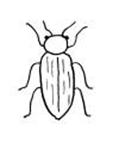
Woodworm in roofs
One of the things that we learnt when we were training as surveyors was that lots of woodworm came from the old packing boxes and tea chests that used to be used when moving house. Often this isn't the case today with cardboard or plastic boxes being used but it did lead to a lot of cases from what we understand of woodworm in roofs. As such as a Surveyor this is one of the areas we investigate. The million, or should it be billion, dollar question is, is the woodworm active?
The other thing that any trainee Surveyor learns is that most woodworm is not active and the real skill is to establish whether the woodworm is active or not. We can take that a step further and say the real skill is first of all to spot the places where woodworm is most likely to be as sometimes in roofs it can be in isolated areas. It's no good looking in one part of the roof if it is more likely to be in another part of the roof. So whilst woodworm is easy to spot you need to know where to look.
It was recently commented with regards to a survey that we carried out that we were at the property only a few hours where the previous surveyor had been there all day. We can only comment that the other building surveyor didn't know where to look in the property and was not very confident in his knowledge to spend all day at the property and it is this important thing of the knowledge a person has that can make such a difference.
Use a Building Surveyor to look for woodworm, not a woodworm treatment company
This is a problem we come across time and time again where a woodworm treatment company or a woodworm specialist, or a builders or a company caring for property and maintaining it has advised that there is woodworm in the property which of course is what they will do because they will have often given a free survey and remember that there is no such thing as a free meal. They will then of course be looking for work to be carried out. Be very aware of the invested interest anyone has when looking for woodworm. We as Surveyors are only looking to advise on what we actually see and we are not looking for any further work.
Enough talk about woodworm, let's have a look at some!
Can you see any woodworm in this photo?
You may just about be able to see some minor signs of woodworm between the hammer and the screwdriver. The question is would you have been able to spot this woodworm with the carpet over the top of it?
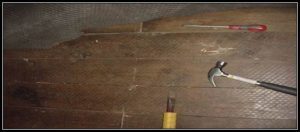
Opening up the floor reveals the extent of the woodworm
Opening up a small section of the floor you can see the frass which indicates the active woodworm.
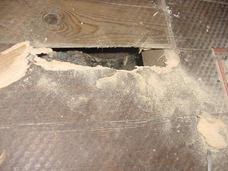
Frass from woodworm activity
This is still only one floorboard wide by approximately 300 mm. You can see the amount of deterioration to the timber and the dust is the frass which is the chewed up sawdust by the woodworm.

Opening up a slightly larger
section
How did we spot the woodworm?
Due to factors that we have seen outside the property and inside the property we suspected there would be woodworm in the floor. We lifted up the floor to the corner of a bay window in a Victorian property with a suspended timber floor. For any Building Surveyor these signs should ring a bell that there is possibly woodworm.
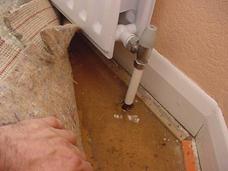
Exposing the floor
A damp meter is only as good as the person that uses it
We use a damp meter reader to check the moisture level of the floor. Even though this had a hardboard over it we know and understand the readings that our damp meter gives and we believe there was dampness below and as you know from the pictures above when we opened up the floor there was woodworm in it.
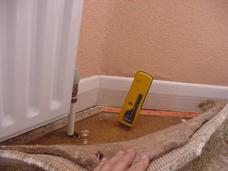
Getting the damp meter reading
How did we spot this woodworm?
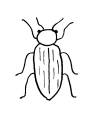
What we could see outside and what we see time and time again is an area of driveway that has been put in too high. In this case the brick pave driveway but often we see a tarmac driveway. This then causes the airbrick to act as a gutter.

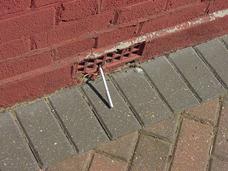
Airbrick acting as a gutter,
allowing water into the
building
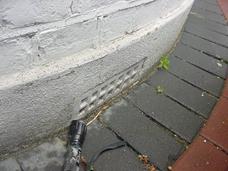
The brick pavers too high

Too high again
Where there is a suspended timber floor the floor needs an airflow underneath it to properly ventilate and stop dampness and woodworm. Without this and water pouring in as it is now acting as a gutter it's very likely there is woodworm.

A suspended timber floor looks
like this
So how do you solve this problem?
The great thing about being a Surveyor is that you don't have to solve the problem using the product you are selling, i.e. if we spot damp we don't have to recommend a damp proof chemical course (which we don't believe works in most cases anyhow) and as in this case where we spot woodworm we don't need to recommend a chemical treatment. We are able to select from a range of solutions.
One of them is to protect the airbricks and this then stops the water discharging into the airbrick and acting as a gutter. Another way could be to add a French drain.
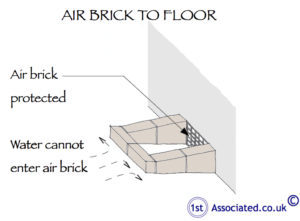
What is a French drain?
This is an area dug out by the side of the property and a perforated pipe placed in the base and shingle on top of it. This then means that any dampness that does come towards the building transfers through the shingle and into the perforated pipe and then ideally into a drain. You do need to make sure that the French drain is a proper French drain and doesn't cause you more problems by just positioning all the rain in one area.

A French drain
We hope this helps you to see how Surveyors can be of use to you.
Other articles on our website that we feel may be of interest to you are:
French Drains
Damp Proof Courses, What are these for?
Damp Proof Courses in Older Properties
Dampness Problems
Damp Walls
Dampness, A Different View
Independent Building Surveyors
We hope this article has been of interest to you but as we are only human, if you feel any of the information we have given is incorrect please do not hesitate to contact us.
Our Free phone number is 0800 298 5424 . Please call us for all of your Building Surveys, Engineers Reports, Specific Defects Reports, Structural Surveys and Homebuyers Reports. We would love to hear from you.
All Rights Reserved
The contents of the website are for general information only and are not intended to be relied upon for specific or general decisions. Appropriate independent professional advice should be paid for before making such a decision.
All rights are reserved the contents of the website are not to be reproduced or transmitted in any form in whole or part without the express written permission of www.1stAssociated.co.uk

